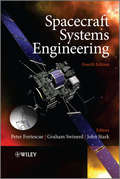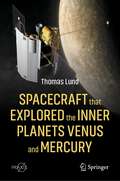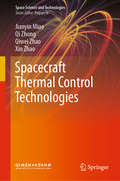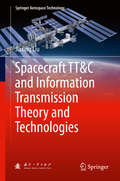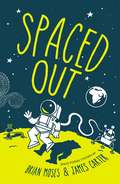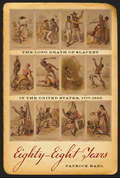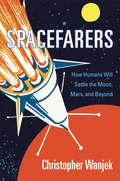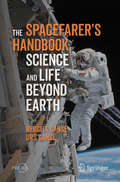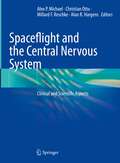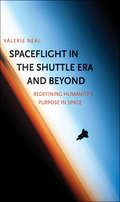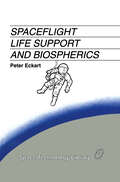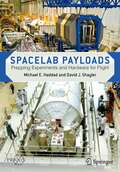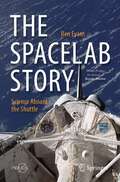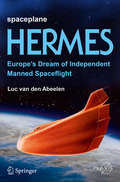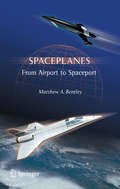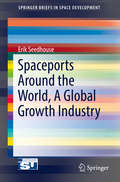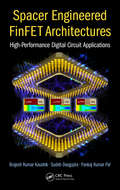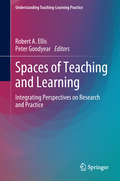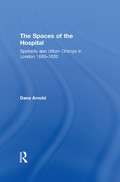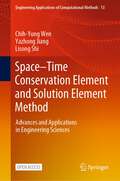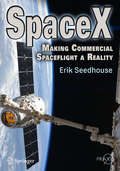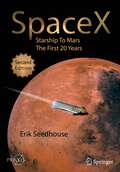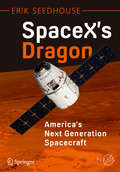- Table View
- List View
Spacecraft Systems Engineering (Aerospace Series)
by Peter Fortescue Graham Swinerd John StarkThis fourth edition of the bestselling Spacecraft Systems Engineering title provides the reader with comprehensive coverage of the design of spacecraft and the implementation of space missions, across a wide spectrum of space applications and space science. The text has been thoroughly revised and updated, with each chapter authored by a recognized expert in the field. Three chapters – Ground Segment, Product Assurance and Spacecraft System Engineering – have been rewritten, and the topic of Assembly, Integration and Verification has been introduced as a new chapter, filling a gap in previous editions. This edition addresses ‘front-end system-level issues’ such as environment, mission analysis and system engineering, but also progresses to a detailed examination of subsystem elements which represents the core of spacecraft design. This includes mechanical, electrical and thermal aspects, as well as propulsion and control. This quantitative treatment is supplemented by an emphasis on the interactions between elements, which deeply influences the process of spacecraft design. Adopted on courses worldwide, Spacecraft Systems Engineering is already widely respected by students, researchers and practising engineers in the space engineering sector. It provides a valuable resource for practitioners in a wide spectrum of disciplines, including system and subsystem engineers, spacecraft equipment designers, spacecraft operators, space scientists and those involved in related sectors such as space insurance. In summary, this is an outstanding resource for aerospace engineering students, and all those involved in the technical aspects of design and engineering in the space sector.
Spacecraft that Explored the Inner Planets Venus and Mercury (Springer Praxis Books)
by Thomas LundA series of increasingly capable spacecraft were sent to explore the inner planets Venus and Mercury. The history of that planetary exploration is traced in this book along with the evolution of sophisticated spacecraft that unveiled long-sought secrets of the planets. The spacecraft were ingenious and reflected the best efforts of talented people working with the available technology of the day. Additionally, this book showcases engineering involved in those capable machines. A consecutive series of 34 planetary spacecraft, which span the time period 1961 to 2021, are described. This includes the unsuccessful missions of several early spacecraft that paved the way for a better understanding of Venus’ hostile environments. This book will describe many successful spacecraft sent to Venus by the Soviet Union and many successful spacecraft sent to Venus and to Mercury by the United States.The recent exploration of Venus by the European Space Agency’s Venus Express and the Japanese spacecraft Akatsuki can also be found in this book. The author draws on over 50 years of experience on aircraft and spacecraft systems to tell the story of these planetary spacecraft. The spacecraft experience includes being the technical lead for the landing radars on the Surveyor and Apollo lunar landers as well as providing analyses for the rendezvous radar for the Space Shuttle. Practical engineering experience is augmented by Master’s degrees in electrical engineering, physics, and business administration.
Spacecraft Thermal Control Technologies (Space Science and Technologies)
by Jianyin Miao Qi Zhong Qiwei Zhao Xin ZhaoThis book presents fundamental theories, design and testing methodologies, and engineering applications concerning spacecraft thermal control systems, helping readers gain a comprehensive understanding of spacecraft thermal control systems and technologies. With abundant design methods, advanced technologies and typical applications to help them grasp the basic concepts and principles of engineering applications, it is mainly intended for engineering and technical staff engaged in spacecraft thermal control areas. The book discusses the thermal environments commonly used for space flight missions, rules and regulations for system design, thermal analysis and simulation, and thermal testing methods, as well as the design and validation of the thermal control systems for Chinese spacecraft, such as the Shenzhou spacecraft and Chang’e Lunar Lander and Rover. It also introduces them to communication and remote sensing satellites and presents advanced thermal control technologies developed in recent years, including heat transfer, heat insulation, heating, refrigeration and thermal sensor technologies. Addressing the design and validation of thermal control systems for various types of Chinese spacecraft, the book offers a valuable theoretical and practical reference guide for researchers and engineers alike.
Spacecraft TT&C and Information Transmission Theory and Technologies (Springer Aerospace Technology)
by Jiaxing LiuSpacecraft TT&C and Information Transmission Theory and Technologies introduces the basic theory of spacecraft TT&C (telemetry, track and command) and information transmission. Combining TT&C and information transmission, the book presents several technologies for continuous wave radar including measurements for range, range rate and angle, analog and digital information transmissions, telecommand, telemetry, remote sensing and spread spectrum TT&C. For special problems occurred in the channels for TT&C and information transmission, the book represents radio propagation features and its impact on orbit measurement accuracy, and the effects caused by rain attenuation, atmospheric attenuation and multi-path effect, and polarization composition technology. This book can benefit researchers and engineers in the field of spacecraft TT&C and communication systems.Liu Jiaxing is a professor at The 10th Institute of China Electronics Technology Group Corporation.
Spaced Out: Space poems chosen by Brian Moses and James Carter
by James Carter Brian MosesBlast off into space and explore the galaxies with a constellation of illustrated poems about the sun, moon and stars, black holes and worm holes, asteroids and meteorites, and even weird alien life forms. From shape poems and free verse to rhymes, kennings and haikus, Spaced Out will take you on an intergalactic adventure. Join Brian Moses and James Carter and a wealth of new and established poets to discover your inner space cadet!This starry collection is the perfect way to get children interested in poetry.
Spaced Out: Space poems chosen by Brian Moses and James Carter (Bloomsbury Revelations Ser.)
by James Carter Brian MosesBlast off into space and explore the galaxies with a constellation of illustrated poems about the sun, moon and stars, black holes and worm holes, asteroids and meteorites, and even weird alien life forms. From shape poems and free verse to rhymes, kennings and haikus, Spaced Out will take you on an intergalactic adventure. Join Brian Moses and James Carter and a wealth of new and established poets to discover your inner space cadet!This starry collection is the perfect way to get children interested in poetry.
Spacefarers: How Humans Will Settle the Moon, Mars, and Beyond
by Christopher WanjekA wry and compelling take on the who, how, and why of near-future colonies in space. From bone-whittling microgravity to eye-popping profits, the risks and rewards of space settlement have never been so close at hand. More than fifty years after the Apollo 11 moon landing, why is there so little human presence in space? Will we ever reach Mars? What will it take to become a multiplanet species, colonizing the solar system and traveling to other stars? Spacefarers meets these questions head on. While many books have speculated on the possibility of living beyond the Earth, few have delved into the practical challenges or plausible motives for leaving the safe confines of our home planet. Christopher Wanjek argues that there is little doubt we will be returning to the Moon and exploring Mars in the coming decades, given the potential scientific and commercial bonanza. Private industry is already taking a leading role and earning profits from human space activity. This can be, Wanjek suggests, a sustainable venture and a natural extension of earthbound science, business, and leisure. He envisions hotels in low-earth orbit and mining, tourism, and science on the Moon. He also proposes the slow, steady development of science bases on Mars, to be followed by settlements if Martian gravity will permit reproduction and healthy child development. An appetite for wonder will take us far, but if we really want to settle new worlds, we’ll need the earnest plans of engineers, scientists, and entrepreneurs. Wanjek introduces us to those planners, who are striving right now to make life in space a reality.
The Spacefarer's Handbook: Science and Life Beyond Earth (Springer Praxis Books)
by Bergita Ganse Urs GanseNow is the time to fly to space! New technological developments, commercialisation of spaceflight and advances in space medicine have made human space travel more attainable than ever before.This entertaining but nevertheless authoritative book gives a practical introduction to space travel from a number of viewpoints: How spacecraft are built, how to steer and navigate them, instructions for a comfortable everyday life in space and a guide to remain healthy and strong in weightlessness. The Spacefarer's Handbook is full of advice, tips and anecdotes to prepare the reader for their own trip to space. At the same time, it does not lose the scientific perspective on spaceflight. The authors, a physicist and a space medicine specialist, explain the underlying concepts rigorously and include recent research findings. From the operating principles of rocket engines, via bone loss in weightlessness to the methane lakes of Titan, this book contains everything aspiring spacefarers need to know! It also serves as a very good resource, beyond general space enthusiasts, for science fiction readers & writers who are looking for a better foundation in space flight."Highly recommended for everyone who wants to fly to space and all passengers of our mothership Earth!"Hans Schlegel, ESA Astronaut
Spaceflight and the Central Nervous System: Clinical and Scientific Aspects
by Alex P. Michael Christian Otto Millard F. Reschke Alan R. HargensThis book consolidates the current knowledge of how short and long-duration spaceflight affects the anatomy and physiology of the central nervous system. It also incorporates the methodology and constraints of studying the central nervous system in space. Chapters detail advances in imaging techniques available to assess intracranial and intraocular pathology as well as translational medicine with an emphasis on brain cancer and neurodegenerative disease in spaceflight. Additionally, the book offers theoretical background information, tested laboratory protocols, and step-by-step methods for reproducible lab experiments to aid neuroscientists and neurobiologists in laboratory testing and experimentation. Spaceflight and the Central Nervous System is the first to comprehensively include all aspects of spaceflight-induced changes in the central nervous system. It is an invaluable resource for basic and clinical laboratory trainees and researchers in aerospace medicine and physiology or for those looking to gain specific knowledge in spaceflight neuroscience.
Spaceflight in the Shuttle Era and Beyond: Redefining Humanity's Purpose in Space
by Valerie NealAn exploration of the changing conceptions of the iconic Space Shuttle and a call for a new vision of spaceflight The thirty years of Space Shuttle flights saw contrary changes in American visions of space. Valerie Neal, who has spent much of her career examining the Space Shuttle program, uses this iconic vehicle to question over four decades’ worth of thinking about, and struggling with, the meaning of human spaceflight. She examines the ideas, images, and icons that emerged as NASA, Congress, journalists, and others sought to communicate rationales for, or critiques of, the Space Shuttle missions. At times concurrently, the Space Shuttle was billed as delivery truck and orbiting science lab, near-Earth station and space explorer, costly disaster and pinnacle of engineering success. The book’s multidisciplinary approach reveals these competing depictions to examine the meaning of the spaceflight enterprise. Given the end of the Space Shuttle flights in 2011, Neal makes an appeal to reframe spaceflight once again to propel humanity forward.
Spaceflight Life Support and Biospherics (Space Technology Library #5)
by P. EckartSpaceflight Life Support and Biospherics is the introduction to space life support systems and artificial ecosystems that has so far been lacking. It is a source of information for everyone involved in the life support system design and development process - engineers, scientists, and students - as well as all those who are simply interested in this existing discipline. The structure of this book is such that it gives step-by-step answers to the basic questions concerning life support systems on any scale - from small microbial systems to the Earth's biosphere: Why life support system development and biosphere research? How does our natural life support system, the biosphere, work? What are the environmental conditions for life support systems in space? What are the fundamental terms and requirements of life support? Which physicochemical life support subsystems currently exist? Which are the potential bioregenerative life support technologies of the future? What are life support systems of future planetary habitats going to look like? What are the experiences of the largest artificial ecosystem - Biosphere 2? What are the potential terrestrial benefits of life support development? £/LIST£
Spacelab Payloads: Prepping Experiments and Hardware for Flight (Springer Praxis Books)
by David J. Shayler Michael E. HaddadSpacelab was a reusable laboratory facility that was flown on the Space Shuttle from 1983 to 1998. Completing 22 major missions and contributing to many other NASA goals, Spacelab stands as one of the Shuttle program’s most resounding successes. The system comprised multiple components, including a pressurized laboratory module, unpressurized carrier pallets and other related hardware, all housed in the Shuttle’s Payload Bay and crew compartment. But how did all those varied components actually come together? The answer is the little-known “Level-IV”, a team of managers and engineers who molded separate elements of hardware into cohesive and safe payloads. Without the dedication and drive of the Level-IV team, the huge successes of the Spacelab missions would not have been achieved. This is their story. You will learn herein how Level-IV was formed, who was involved, and the accomplishments, setbacks and problems faced along the way, in a story that blends both the professional and personal sides of Level-IV operations and its legacy. Upon reading this book, you will gain a new appreciation for this crucial team and understand what is meant when you hear the term “Level-IV”.
The Spacelab Story: Science Aboard the Shuttle (Springer Praxis Books)
by Ben EvansBetween 1983 and 1998, Spacelab provided NASA with a vital short-term laboratory in space. Across more than a dozen missions, Spacelab’s pressurized research modules and science pallets supported hundreds of experiments from the life to microgravity sciences, from Earth science to astrophysics and from materials processing to fluid dynamics. For the first time, The Spacelab Story sheds light on all the Spacelab missions that served as pathfinders for the eventual International Space Station, along with all the flights that never came to be. The book chronicles over two decades of service and international partnership with Germany, Japan, Canada, Russia, the member-states of the European Space Agency and others. The very same international co-operation that led to Spacelab’s genesis also conspired to create its end. Science writer Ben Evans chronicles this tumultuous history, showing how, as tensions between the superpowers cooled in the 1990s and the Shuttle cameto be increasingly used to fly joint missions to Mir, many Spacelab missions were delayed and eventually cancelled. This book is a must-read for anybody interested in the science conducted aboard the Shuttle, the experimental precursors of the ISS, and the international politics surrounding NASA’s pioneering space endeavors.
Spaceplane HERMES: Europe's Dream of Independent Manned Spaceflight (Springer Praxis Books)
by Luc van den AbeelenThis is the first comprehensive book on the European Hermes program. It tells the fascinating story of how Europe aimed for an independent manned spaceflight capability which was to complement US and Soviet/Russian space activities. In 1975, France decided to expand its plans for automated satellites for materials processing to include the development of a small 10 ton spaceplane to be launched on top of a future heavy-lifting Ariane rocket. This Hermes spaceplane would give Europe its own human spaceflight capability for shuttling crews between Earth and space stations. The European Space Agency backed the proposal. Unfortunately, after detailed studies, the project was cancelled in 1993. If Hermes had been introduced into service, it could have become the preferred "space taxi" for ferrying crews to and from the International Space Station. But that opportunity was lost. This book provides the first look of the complete story of and reasons for the demise of this ambitious program. It also gives an account which pieces of Hermes survived and are active in the 2nd decade of the 21st century. This fascinating story will be a great read for space enthusiasts. But it will also serve as a comprehensive documentation of an important episode in the history of manned spaceflight.
Spaceplanes: From Airport to Spaceport
by Matthew A. BentleySpaceplanes From Airport to Spaceport presents a coherent, lucid, and optimistic picture of the future of the near future. Space vehicles may soon take off from international airports and refuel in space. New technologies could allow flights to take off regularly between the Earth and the Moon. The technical details presented explain precisely how all this can be accomplished within the next few decades. This book also explains why the Space Tourist market could easily become the single most important factor in the mid-term future development of space transportation. In a few years it will be possible to board a spaceplane and fly into Earth orbit, and perhaps visit a space station. Later development could include refuelling in orbit to take a tour of cislunar space. The book's solid engineering foundation will be of interest to both space exploration enthusiasts and future space travelers.
Spaceports Around the World, A Global Growth Industry (SpringerBriefs in Space Development)
by Erik SeedhouseThis brief presents a concise description of the existing spaceport market, the technologies being tested and developed at them, and the private companies that are making them possible. While NASA has its own plan for the future of space exploration, one that includes a new shuttle, an interplanetary spacecraft, and astronauts going to Mars, many people believe that the real future of space exploration is currently centered around dozens of commercial spaceports, financed by entrepreneurs inspired not only by profit but by the dream of creating a new space age, one not limited by bureaucracies or by budget allocations.Commercial spaceports in Florida, Texas, Oklahoma, Virginia and Alaska, as well as in countries like Curaçao and Sweden, are becoming home to dozens of private aerospace companies and provide a place where cutting-edge technology can be developed, tested and launched into space. Based on original interviews with principles at the various companies involved and on-site observations at the Mojave Air and Space Port, the author traces the early days of the spaceport movement and outlines what lies ahead.
Spacer Engineered FinFET Architectures: High-Performance Digital Circuit Applications
by Sudeb Dasgupta Brajesh Kumar Kaushik Pankaj Kumar PalThis book focusses on the spacer engineering aspects of novel MOS-based device–circuit co-design in sub-20nm technology node, its process complexity, variability, and reliability issues. It comprehensively explores the FinFET/tri-gate architectures with their circuit/SRAM suitability and tolerance to random statistical variations.
Spacer Engineered FinFET Architectures: High-Performance Digital Circuit Applications
by Sudeb Dasgupta Brajesh Kumar Kaushik Pankaj Kumar PalThis book focusses on the spacer engineering aspects of novel MOS-based device–circuit co-design in sub-20nm technology node, its process complexity, variability, and reliability issues. It comprehensively explores the FinFET/tri-gate architectures with their circuit/SRAM suitability and tolerance to random statistical variations.
Spaces of Teaching and Learning: Integrating Perspectives on Research and Practice (Understanding Teaching-Learning Practice)
by Robert A. Ellis Peter GoodyearThis integrated collection of perspectives on the spaces of teaching and learning uses ‘learning space’ to place educational practice in context. It considers the complex relationships involved in the design, management and use of contemporary learning spaces. It sheds light on some of the problems of connecting the characteristics of spaces to the practices and outcomes of teaching and learning. The contributions show how research into learning spaces can inform broader educational practices and how the practices of teaching, learning and design can inform research. The selection of chapters demonstrates the value of gathering together multiple sources of evidence, viewed through different epistemological lenses in order to push the field forward in a timely fashion. The book provides both a broad review of current practices as well as a deep-dive into particular educational and epistemological challenges that the various approaches adopted entail. Contrasts and commonalities between the different approaches emphasise the importance of developing a broad, robust evidence-base for practice in context. This is the inaugural book in the series Understanding Teaching-Learning Practice.
The Spaces of the Hospital: Spatiality and Urban Change in London 1680-1820
by Dana ArnoldThe Spaces of the Hospital examines how hospitals operated as a complex category of social, urban and architectural space in London from 1680 to 1820. This period witnessed the transformation of the city into a modern metropolis. The hospital was very much part of this process and its spaces, both interior and exterior, help us to understand these changes in terms of spatiality and spatial practices. Exploring the hospital through a series of thematic case studies, Dana Arnold presents a theoretically refined reading of how these institutions both functioned as internal discrete locations and interacted with the metropolis. Examples range from the grand royal military hospital, those concerned with the destitute and the insane and the new cultural phenomenon of the voluntary hospital. This engaging book makes an important contribution to our understanding of urban space and of London, uniquely examining how different theoretical paradigms reveal parallel readings of these remarkable hospital buildings.
The Spaces of the Hospital: Spatiality and Urban Change in London 1680-1820
by Dana ArnoldThe Spaces of the Hospital examines how hospitals operated as a complex category of social, urban and architectural space in London from 1680 to 1820. This period witnessed the transformation of the city into a modern metropolis. The hospital was very much part of this process and its spaces, both interior and exterior, help us to understand these changes in terms of spatiality and spatial practices. Exploring the hospital through a series of thematic case studies, Dana Arnold presents a theoretically refined reading of how these institutions both functioned as internal discrete locations and interacted with the metropolis. Examples range from the grand royal military hospital, those concerned with the destitute and the insane and the new cultural phenomenon of the voluntary hospital. This engaging book makes an important contribution to our understanding of urban space and of London, uniquely examining how different theoretical paradigms reveal parallel readings of these remarkable hospital buildings.
Space–Time Conservation Element and Solution Element Method: Advances and Applications in Engineering Sciences (Engineering Applications of Computational Methods #13)
by Chih-Yung Wen Yazhong Jiang Lisong ShiThis open access book introduces the fundamentals of the space–time conservation element and solution element (CESE) method, which is a novel numerical approach for solving equations of physical conservation laws. It highlights the recent progress to establish various improved CESE schemes and its engineering applications. With attractive accuracy, efficiency, and robustness, the CESE method is particularly suitable for solving time-dependent nonlinear hyperbolic systems involving dynamical evolutions of waves and discontinuities. Therefore, it has been applied to a wide spectrum of problems, e.g., aerodynamics, aeroacoustics, magnetohydrodynamics, multi-material flows, and detonations. This book contains algorithm analysis, numerical examples, as well as demonstration codes. This book is intended for graduate students and researchers who are interested in the fields such as computational fluid dynamics (CFD), mechanical engineering, and numerical computation.
SpaceX: Making Commercial Spaceflight a Reality (Springer Praxis Books)
by Erik SeedhouseThis first account of commercial spaceflight’s most successful venture describes the extraordinary feats of engineering and human achievement that have placed SpaceX at the forefront of the launch industry and made it the most likely candidate for transporting humans to Mars. Since its inception in 2002, SpaceX has sought to change the space launch paradigm by developing a family of launch vehicles that will ultimately reduce the cost and increase the reliability of space access tenfold. Coupled with the newly emerging market for governmental, private, and commercial space transport, this new model will re-ignite humanity's efforts to explore and develop space. Formed in 2002 by Elon Musk, the founder of PayPal and the Zip2 Corporation, SpaceX has already developed two state-of-the-art new launch vehicles, established an impressive launch manifest, and been awarded COTS funding by NASA to demonstrate delivery and return of cargo to the ISS. This book describes how simplicity, low-cost, and reliability can go hand in hand, as promoted in the philosophy of SpaceX. It explains how, by eliminating the traditional layers of internal management and external sub-contractors and keeping the vast majority of manufacturing in house, SpaceX reduces its costs while accelerating decision making and delivery, controls quality, and ensures constant liaison between the design and manufacturing teams.
SpaceX: Starship to Mars – The First 20 Years (Springer Praxis Books)
by Erik SeedhouseLearn about commercial spaceflight’s most successful startup in this fully updated book, which follows the extraordinary feats of engineering and human achievement that have placed SpaceX at the forefront of the launch industry and positioned it as the most likely candidate for transporting humans to Mars. This second edition emphasizes SpaceX's much-hyped manned mission to the Red Planet. With a plethora of new material gathered from 2013 to the present, the text offers the most up-to-date portrait of the maverick band of scientists and engineers producing some of the most spectacular aviation triumphs of the 21st century. Topics covered in this book include: all CRS flights, the challenges of developing retro-propulsion, and the pathway towards realizing the Falcon Heavy and BFR. In addition, the chapters describe SpaceX’s emphasis on simplicity, low-cost, and reliability, and the methods the company employs to reduce its costs while speeding up decision-making and delivery. Detailing the Falcon 1, Falcon 9 and Falcon Heavy launch vehicles, the book shows how SpaceX is able to offer a full spectrum of light, medium, and heavy lift launch capabilities to its customers and how it is able to deliver spacecraft into any inclination and altitude, from low Earth orbit to geosynchronous orbit to planetary missions. This book is the perfect go-to guide on SpaceX for anybody working or interested in the commercial space arena.
SpaceX's Dragon: America's Next Generation Spacecraft (Springer Praxis Books)
by Erik SeedhouseDragon V2 is a futuristic vehicle that not only provides a means for NASA to transport its astronauts to the orbiting outpost but also advances SpaceX’s core objective of reusability. A direct descendant of Dragon, Dragon V2 can be retrieved, refurbished and re-launched. It is a spacecraft with the potential to completely revolutionize the economics of an industry where equipment costing hundreds of millions of dollars is routinely discarded after a single use. It was presented by SpaceX CEO Elon Musk in May 2014 as the spaceship that will carry NASA astronauts to the International Space Station as soon as 2016.SpaceX’s Dragon – America’s Next Generation Spacecraft describes the extraordinary feats of engineering and human achievement that have placed this revolutionary spacecraft at the forefront of the launch industry and positioned it as the precursor for ultimately transporting humans to Mars. It describes the design and development of Dragon, provides mission highlights of the first six Commercial Resupply Missions, and explains how Musk hopes to eventually colonize Mars.
